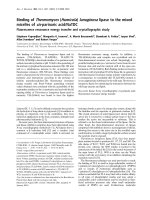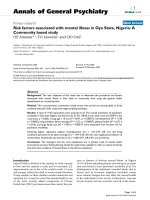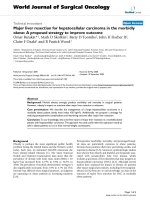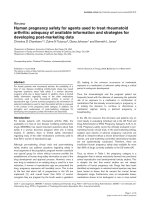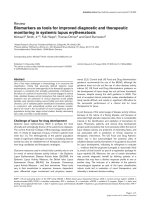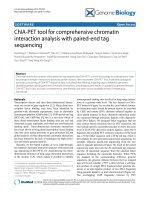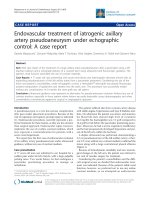Báo cáo y học: " Risk scoring systems for adults admitted to the emergency department: a systematic review" potx
Bạn đang xem bản rút gọn của tài liệu. Xem và tải ngay bản đầy đủ của tài liệu tại đây (336.85 KB, 8 trang )
REVIEW Open Access
Risk scoring systems for adults admitted to the
emergency department: a systematic review
Mikkel Brabrand
1*
, Lars Folkestad
1
, Nicola Groes Clausen
2
, Torben Knudsen
1
, Jesper Hallas
3
Abstract
Background: Patients referred to a medical admission unit (MAU) represent a broad spectrum of disease severity.
In the interest of allocating resources to those who might potentially benefit most from clinical interventions,
several scoring systems have been proposed as a triaging tool.
Even though most scoring systems are not meant to be used on an individual level, they can support the more
inexperienced doctors and nurses in assessing the risk of deterioration of their patients.
We therefore performed a systematic review on the level of evidence of literature on scoring systems developed or
validated in the MAU. We hypothesized that existing scoring systems would have a low level of evidence and only
few systems would have been externally validated.
Methods: We conducted a systematic search using Medline, EMBASE and the Cochrane Library, according to the
PRISMA guidelines, on scoring systems developed to assess medical patients at admission.
The prim ary endpoints were in-hospital mortality or transfer to the intensive care unit. Studies derived for only a
single or few diagnoses were excluded.
The ability to identify patients at risk (discriminatory power) and agreement betwe en observed and predicted out-
come (calibration) along with the method of derivation and validation (application on a new cohort) were
extracted.
Results: We identified 1,655 articles. Thirty were selected for further review and 10 were included in this review.
Eight systems used vital signs as variables and two relied mostly on blood tests.
Nine systems were derived using regression analysis and eight included patients admitted to a MAU. Six systems
used in -hospital mortality as their primary endpoint.
Discriminatory power was specified for eight of the scoring systems and was acceptable or better in five of these.
The cali bration was only specified for four scoring systems. In none of the studies impact analysis or inter-observer
reliability were analyzed.
None of the systems reached the highest level of evidence.
Conclusions: None of the 10 scoring systems presented in this article are perfect and all have their weaknesses.
More research is needed before the use of scoring systems can be fully implemented to the risk assessment of
acutely admitted medical patients.
Background
Patients referred to a medical admission unit (MAU)
represent a b road spectrum o f disease severity. In t he
interest of allocating resource s to those who might
potentially benefit most from clinical interventions, sev-
eral scoring systems have been proposed as a triaging
tool.
McClish et al[1] has shown that in a critical care
environment, physicians outperform scoring systems
when assessing groups o f patients at the extremes of
risk of deterioration. Patients doing very poorly or very
well are easily identified, but when assessing the in-
between group scoring, systems were better than clinical
experience.
Apart from the assessment of patient risk, scoring sys-
tems can be used in clinical trials to account f or the
severity of disease in the subjects included in the trial,
* Correspondence:
1
Department of Medicine, Sydvestjysk Sygehus, Esbjerg, Denmark
Brabrand et al. Scandinavian Journal of Trauma, Resuscitation and Emergency Medicine 2010, 18:8
/>© 2010 Brabrand et al; licensee BioMed Central Ltd. This is an Open Access article distributed under the terms of the Creative
Commons Attr ibution License (http ://creativecommons.org/licenses/b y/2.0), which permits unrestricted use, distri bution, and
reproduction in any medium, provided the original work is properly cited.
or to adjust for case-mix when benchmarking the per-
formance of clini cal units. Finally , they can be used to
monitor the effect of new technology. Most systems are
not developed to be used on an individual level but on
groups of patients.
The development of scoring syste ms began in the
intensive care environment (ICU). Systems such as
Acute Physiology and Chronic Health Evaluation
(APACHE)[2], the Mortality Probability Models (MPM)
[3] and Sequential Organ Failure Assessment (SOFA)[4]
scores were developed and validated in ICU’s. Later, the
Emergency Medicine community caught on and scoring
systems for this environment were developed.
Even though most scoring systems are not meant to
be used on an individual level, they sometimes will be
used by more inexperienced doctors and nurses in
assessing the risk of deterioration of their patients. To
clarify the level of evidence in this field, we therefore
decided to perform a systematic review of the literature
on scoring systems developed or validated in the MAU.
We hypothesized that the existing scoring systems
would have a low level of evidence and that only few
systems existed that had been externally validated.
Materials and methods
Our protocol (available upon request from the authors)
asked for inclusion of all clinical studies concerning
adult medical patients admitted to the hospital whether
through the Emergency Department or an admission
unit. The protocol and data extraction was conducted
according to the 2009 PRISMA guidelines[5], the com-
pleted checklist is available from the authors upon
request. We defined the relevant outcome to be either
in-hospital mortality (at any point in time) or transfer to
the ICU. Only studies validating variables using a rele-
vant scientific principle (regre ssion analysis, discriminate
analysis, recursive partitioning analysis or neural net-
work) and not derived for only a single or a few diag-
noses (e.g. only critically ill patients admitted to the ICU
or patients admitted with sepsis) were included. The
system had to be practicable without requ iring extensive
computer resources.
Thus, we conducted a search of PubMed (1950 till
2008 week 38) using the MeSH Terms ("Intensive Care
Unit” OR “ Mortality”)AND“Health Status Indicators”
AND ("Patient admission” OR “Hospitalization” ). We
also searched EMBASE (from 1980 till 2008 week 38)
using the terms (including related terms) ("Mortality”
OR “IntensiveCareUnit”)AND“ Scoring system”.A
search of The Cochrane Library usin g the term “Scoring
system” was also conducted.
We included literature from our o wn archives, and a
hand-search was conducted in every selected article for
relevant references for inclusion.
The results of searches were analyzed independently
by two authors (MB and NGC). Data were extracted by
two authors (MB and LF) and disagreement was
resolved by consensus.
Whenever possible, we extracted the s coring system’s
discriminatory power (i.e. the ability to identify
patients at increased risk of meeting the outco me),
expressed as the area under receiver operating charac-
teristic curve (AUROC)[6] and its calibration (i.e.
agreement between the predicted and the observed
outcome in the model), expressed as the p-value of the
Hosmer-Lemeshow goodness-of-fit test[7]. AUROC
values above 0.8 were considered as reflecting good
discriminatory power.
In addition, we classified the scoring system’ s level of
evidence by the method suggested by McGinn et al[8]
and ascertained whether the system had been applied on
a new cohort of patients, either at the same location or
at external location (i.e. internal or external validation),
in order to assure that the system is applicable to other
groups than those on which is was developed.
Results
The P ubMed search resulted in 1,587 hits, EMBASE in
68 and the Cochrane Library none.
Thirty articles were selected for further review. Two
were excluded due to use of endpoints other than those
specified in the search strategy, one was a narrative
review, four were conducted in other environments than
the specified, one was a consensus paper, six were for
specified groups of patients and one was not a scoring
system.
Six articles were on track and trigger system s (scorin g
systems normally used to activate in-hospital Medical
Emergency Teams to evalua te patients in acute distress).
One was a review of 33 different systems and this was
included in our review. Two of these six articles
included only pati ents who pre sented to a n Emergency
Department and were thus excluded as the patients
were not later admitted to the hospital.
A total of 13 articles were included in this review, see
figure 1.
The articles presented i n this study are very heteroge-
neous. They originate from different department types
and the case-mix ranges from patients solely a dmitted
by helicopter to all patients discharged from a medical
department. We therefore have chosen to focus only the
parts of the scoring systems we find important for asses-
sing their relevancy; i.e. which variables have the authors
chosen to include, which statistical methods were cho-
sen to design and test the systems, what was the discri-
minatory power and calibration of the systems (i.e. how
usable are the systems) and which level of evidence does
the systems achieve.
Brabrand et al. Scandinavian Journal of Trauma, Resuscitation and Emergency Medicine 2010, 18:8
/>Page 2 of 8
Track and trigger systems
Two of the papers on track and trigger systems were
written by Subbe et al. One analyzed the Early Warning
Score (EWS)[9] and the other the Modified Early Warn-
ing S core (MEWS)[10] on patients admitted to or
through a MAU. None of these articles presented data
on discriminatory power or calibration. When calculat-
ing the EWS, the authors found that a maximum score
of five was associated with an in creased risk o f death,
ICU and HDU admission[9]. When the authors stratified
patients into three risk bands according to the MEWS
score, they only f ound a statistical significant increased
incidence of ca rdiac arrest in the int ermediary risk band
i.e. MEWS 3-4[10].
Paterson et al. inc luded medical and surgical patients
admitted to a combined assessment area in their study
[11]. The object was to evaluate the implementation of a
standardized early warning scoring system (SEWS). A
total of 848 patients were included, 435 after the imple-
mentation of SEWS. In the SEWS cohort, they found a
significant linear relationship between in-hospital mor-
tality and admission SEWS score (chi-squared 34.3,
p < 0.001). Data on discrimination were not presented.
As the revie w by Smith et al. is included in our article
(here referred to as TTS) and included the studies by
both Subbe et al. and Paterson et al., these will not be
presented in further detail.
Variables included in the scoring systems
All but two of the scoring systems u sed vital signs as
variables when calculating the s core (see table 1). The
Admission Laboratory Tests (ALT)[12] and The Routine
Laboratory Data (RLD)[13] both relied mostly upon
blood tests. Two systems, the Simple Clinical Score
(SCS)[14] and the Hypo tension , Oxygen saturat ion, low
Temperature, ECG changes and Loss of independence
Figure 1 Search strategy used for this article according to the PRISMA guidelines.
Brabrand et al. Scandinavian Journal of Trauma, Resuscitation and Emergency Medicine 2010, 18:8
/>Page 3 of 8
Score (HOTEL)[15] included both subjective and objec-
tive parameters (e.g. dyspnoea and abnormal EKG).
Development of the scoring systems
Regression analysis was the most applied method for
development of the scoring systems, only Track and
Trigger System (TTS)[16] was developed otherwise (see
table 2). Eight of the ten systems included patients
admitted to a medical admission unit, but the popula-
tion in Ra pid Acute Physiology Score (RAPS)[17] was
patients transported to the hospital by helicopter, and
thepopulationintheGoodacre Score (GS) [18] was
patients transported to the em ergency department by
ambulance.
Six sys tems used in-hospital mortality as their prima ry
endpoint and only Early Warning Score (EWS)[19] us ed
a composite endpoint.
Discriminatory power and calibration
Discriminatory power (i.e. the ability to identify patients
at increased risk of meeting t he endpoint) was specified
for eight of the scoring systems (see table 3), but not for
Table 1 Parameters included in the scoring systems
Parameter ALT[12] EWS[19] TTS[16] RLD[13] WPS[20] SCS[14] HOTEL[15] RAPS[17] REMS[21] GS[18]
Age ••• ••
Sex •
Admission (acute or planned) •
Ability to stand unaided ••
Coma •
New stroke •
Dyspnoea •
Nursing home resident •
Diabetes •
Abnormal EKG ••
Spend time in bed prior to admission •
Vital signs
Heart rate •• • • • •
Systolic blood pressure •• • • •
Diastolic blood pressure •
Mean blood pressure ••
Respiratory rate •• • • • •
Temperature •• • • •
Level of consciousness (AVPU) ••
1
•
Level of consciousness (GCS) •
1
•••
Oxygen saturation •• • • • • •
Urine production •
2
Altered mental state •
Blood tests
Albumin ••
Lactate dehydrogenase •
Alanine transaminase •
Aspartate aminotransferase •
Creatinine •
Blood Urea Nitrogen ••
Sodium •
Potassium •
Glucose •
Haemoglobin •
Leucocytes ••
Neutrophilocytes •
1
Either AVPU or GCS according to original study, review article
2
Regarded as normal in all cases (not analyzed in the study), review article
Brabrand et al. Scandinavian Journal of Trauma, Resuscitation and Emergency Medicine 2010, 18:8
/>Page 4 of 8
Table 2 Development data from the studies
Scoring
System
Population Exclusion criteria Endpoint(s) Number of
endpoints
met
Sex Statistic
method
Potential
maximum
population
(before
exclusion)
Sample-size
(% of
potential
maximum
population)
Number of
parameters
analyzed
REMS[21] Patients
admitted to
a non-
surgical
emergency
department
Cardiac arrest with
unsuccessful
resuscitation, more
than one vital sign
missing
In-hospital
mortality
285 (2.4%) 51.6%
female
Multivariate
regression
analysis
12,006 11,751
(97.9%)
8
RAPS[17] Patients
transported
to a
university
hospital by
helicopter
Age younger than 11
years, missing values
24 hours
mortality
36 (12.7%) NS Multivariate
regression
analysis
283 283 (100%) 4
GS[18] Patients
transported
to an
emergency
department
by
ambulance
Trauma, psychiatric
disease, dead on
arrival, discharged
from the ED, outcome
not available at follow-
up, not admitted due
to specified disease
In-hospital
mortality
711 (12.7%) 42.3%
female
Regression
analysis
17,950 5,583 (31.1%) 3
1
HOTEL
[15]
Patients
admitted to
a medical
admission
unit
Age younger than 14,
death < 15 minutes
from arrival, missing
values
Death
within 15
minutes to
24 hours
after arrival
59
2
(0.6%) NS Logistic
regression
11,124 10,290
3
(92.5%)
11
SCS[14] Patients
admitted to
a medical
admission
unit
Age younger than 14 30 days
mortality
316 (4.7%) 47.5%
female
Logistic
regression
11,124 9,964
4
(89.6%)
29
WPS[20] Patients
admitted to
an
emergency
care unit
None In-hospital
mortality
270 (8.5%) 52%
female
Logistic
regression
4,384 3,184 (72.6%) 6
RLD[13] Patients
discharged
from medical
department
Age below 16 at
admission
In-hospital
mortality
NS
5
NS Logistic
regression
17,417 16,7377
6
(96.1%)
7
TTS[16] Patients
admitted to
a medical
admission
unit
Age below 16,
admission directly to
the ICU
In-hospital
mortality
835 (8.4%) 52.3%
female
Comparison
using AUROC
10,051 9,987 (99.4%) 8
7
EWS[19] Patients
admitted to
a medical
admission
unit
None In-hospital
mortality,
length of
stay,
admission
to ICU or
CCU
29
combined
(12.8%), 8
dead (3.5%)
48.5%
female
Logistic
regression
225 225 (100%) 6
ALT[12] Patients in a
medical
emergency
department
No blood test drawn Mortality
while
admitted to
a medical
department
573 (5.6%) 48.6%
female
Logistic
regression
23,397 10,308
(44.1%)
27
NS = not specified
1
saturation only available for 51.4% of the patients
2
40 in the development cohort
3
sample-size divided for validation purposes, 6,947 used for develo pment
4
sample-size divided for validation purposes, 6,736 used for develo pment
5
only specified for validation cohorts
6
sample-size divided for validation purposes, 9,497 used for develo pment
7
either AVPU or GCS. Urine production was set to normal
Brabrand et al. Scandinavian Journal of Trauma, Resuscitation and Emergency Medicine 2010, 18:8
/>Page 5 of 8
RAPS and RLD. It was above 0.8 in five of these, but in
Worthing Physiological Scoring System (WPS)[20] is was
0.74 and in TTS 0.657-0.782.
The calibration (i.e. agreement between the predicted
and the observed outcome in the model) was only speci-
fied for four scoring systems. In The Rapid Emergency
Medicine Score (REMS) [21] it was calculated using the
Chi-square test and was found to be poor, but not
further specified.
In none of the studies impact analysis or inter-obser-
ver reliability were analyzed.
Evidence level
The TTS and EWS reached evidence level two accord-
ing to McGinn et al. The GS only reached level four
whereas the other systems all reached level three. None
of the systems thus reached level one.
Discussion
We identified ten different scoring systems assessing the
risk of in-hospital mortality or admission to an ICU in
acutely a dmitted patients. None of these systems com-
plied with the criteria for the highest levels of scientific
evidence, but all seemed somewhat scientifically sound
and could perhaps be used in a MAU. Most of the scor-
ing systems use primarily vital signs as variables in the
attempt to stratify the patients. The SCS and HOTEL
scoresusesomesubjectivedata(e.g.dyspnoea).The
ALT and RLD use biochemical analyses and therefore
cannot b e calculated on presentation of the patient but
have to await the analyses of blood tests. Data for calcu-
lating the other eight scores are easily obtained at
presentation (except perhaps the EKG needed for calcu-
lation of SCS and HOTEL) and the score can be calcu-
lated at this early point in time. The WPS, EWS, TTS,
SCS, GS, REMS and RAPS use an aggregate weighted
score where increasing abnormality in the variables
results in an increased score (e.g. respiratory rate ≤ 19
scores 0, 20-21 scores 1 and ≥ 22 scores 2). The RLD
and ALT uses a mathematical formula to calculate the
risk (e.g. -10.192 + (-0.013 * gender ) + (5.717 * mode of
admission) + (0.018 * urea) etc.). The HOTEL score
simply adds one point to each of the criteria that are
outside the defined interval (e.g. systolic blood pressure
< 100).
The ability of the scoring system to separate the
patients with increased risk for meeting the specified
outcome ( e.g. mortality) is determined by the discrimi-
natory power. The RAPS, RLD and EWS however, do
not p resent this in their article. As for the other seven
scoring s ystems all have an AUROC above 0.657, indi-
cating at least a fair discriminatory power. Both the
HOTEL s core and the SCS reach impressive AUROC’s
during both development and validation.
Calibration, i.e. the agr eement between the predicted
and the observed outcome across all patients stratified
into subgroups, was not reported systemat ically. In fact,
only four articles (REMS, HOTEL, WPS and partly
ALT) presented data on this subject. In REMS t he cali-
bration was poor, but it was reported as satisfactory to
good in the other studies.
A developed scoring system can only be used if it has
bee n validated (i.e. applied to a new cohort of patients).
Otherwise, the discriminatory power and calibration can
Table 3 Evidence level and validation of scoring systems to predict in-patient mortality in the medical admission unit
Scoring
system
Level of
evidence
1
Validated in a new
population at same site
as developed
Validated in a new
population at an
external location
Discrimination (ability to
identify patients at risk),
AUROC
Calibration (agreement between
predicted and observed risk),
Chi-square
REMS[21] 3 ••0.852 (+/- 0.014) 487.3 (p < 0.0001)
RAPS[17] 3 - • NS NS
GS[18] 4 - - 0.81 (95% CI: 0.78-0.84) NS
HOTEL
[15]
3 • - 0.865 (0.793-0.937)
Validation: 0.854 (0.746-
0.962)
1.49 (p = 0.83)
SCS[14] 3 • - 0.858 (SE 0.009)
Validation: 0.856 (SE 0.013)
NS
WPS[20] 3 • - 0.74 (0.74-0.77) p = 0.119
RLD[13] 3 • -
22
TTS[16] 2 ••
3
0.657-0.782 NS
EWS[19] 2 • - 0.68 (0.65-0.71) NS
ALT[12] 3 • - 0.904
4
NS = not specified
1
according to McGinn et al[8]
2
only specified for validation cohorts
3
several publications validate TTS
4
mentioned to be good, but not specified
Brabrand et al. Scandinavian Journal of Trauma, Resuscitation and Emergency Medicine 2010, 18:8
/>Page 6 of 8
be falsely elevated. There are seve ral ways to validate a
scoring system, but an external validation (i.e. at another
location than were the system was developed) in a sepa-
rate cohort is preferable. However, only three of the sys-
tems were validated externally (REMS, RAPS and TTS)
and one scoring system was not even validated locally
(GS). As described by McGinn et al[8] scoring systems
can be categorized into levels of evidence according to
their method of validation. The scoring systems in this
study to r each the highest levels of evidence (le vel 2)
were “Track and Trigger” systems, also used in activa-
tion of medical emergency teams. All other systems
reached level 3 except the GS which only reached level
4 as it is not validated but only derived.
Most of the parameters used to calculate the scores
are straight-forward, and the calculation does not seem
complicated, perhaps with the exception of RLD a nd
ALT which use a complicated formula derived from
regression analyses. However, as none of the systems
presents reliability data, it is unknown which level of
inter-observer reliability is reached. In some of the scor-
ing systems, a few parameters bear a risk of increased
inter-observer variability, e.g. if the patients have dys-
pnoea (SCS), is able to stand unaided (SCS and
HOTEL) and perhaps respiratory rate (EWS, TTS, WPS,
SCS, RAPS and REMS).
But the main question is if we have any use for scor-
ing systems in today’s world of medicine. One thing is
that scoring systems are capable of predicting mortality
and ICU admissions, but does this have any clinical
importance? Indeed one could argue that scoring sys-
tems bring little extra information to the clinical judg-
ment made by all doctors on their first encounter with a
patient. An example of this was the SUPPORT trial that
showed that providing the physicians with objective out-
come predictions, did no t significantly change physi-
cian’s attitudes and behavior[22,23] when treating their
patients. In order to clarify this, we need studies com-
paring clinical assessment of patients with the combined
effect of clinical assessment and the use of scoring sys-
tems. This has rarely been done in the Emergency
Department, b ut we know from the critical care envir-
onment that physicia ns are good at prediction of mor-
tality in patients by use of their clinical assessment, but
that the use of scoring systems can support their judg-
ment[1,24-26]. But even if it is eventually proven that
scoring systems improve assessment of mortalit y, one
could argue that the introduction of the scoring system
itself forces the clinician to reflect on the risk of the
patient, and that this carries all of the effect. However,
the use of scoring systems will perhaps be able to iden-
tify patients at risk that might be overlooked by the
medical staff and ther eby improve their treatment, and
this alone could justify their existence.
Butmostscoringsystemsaredevelopedforuseon
groups of patients and not on an individual level. How-
ever, this fact is of ten overlooked by our inexperienced
colleagues and the score is applied directly to the
patient. This runs the risk of misclassifying the patient
and thus directing therapy in, perhaps, a wrong direc-
tion. As none of the scoring systems presented in this
paper have had an impact analysis performed, we do not
know if their implement ation will affect clinical therapy.
If we are to use scoring systems as routine part o f our
clinical work, much more research is needed. As a result
of this, we, at the moment, cannot use any of these sys-
tems on an individual level.
Conclusion
When assessing acutely admitted medical patients as a
young and inexperienced doctor, the use of scoring sys-
tems can help identifying patients at risk. We have iden-
tified ten different systems, most of which rely on vital
signs in prognosticating the patients.
None of the systems identified reached the highest
level of evidence as defined by McGinn et al[8]. How-
ever, both the HOTEL score and the SCS were impress-
ive in both discriminatory p ower and calibration. The
REMS showed an acceptable discriminatory power but
poor calibration. As f or calculation, the ALT and RLD
may prove difficult to use, especially compared to the
other scoring systems.
None of the scoring systems presented in this article
are perfect and all have their weaknesses. As such, more
research is needed (especially external validation and
impact analyses) before the use of scoring systems can
be fully implemented to the risk assessment of acutely
admitted medical patients.
Author details
1
Department of Medicine, Sydvestjysk Sygehus, Esbjerg, Denmark.
2
Department of Anesthesiology, Sygehus Lillebælt, Kolding, Denmark.
3
Department of Clinical Pharmacology, Odense University Hospital, Denmark.
Authors’ contributions
NGC and MB conducted the search for relevant articles. LF and MB extracted
data from the articles. All authors participated in drafting, revising and finally
approved the article.
Competing interests
The authors declare that they have no competing interests.
Received: 27 October 2009
Accepted: 11 February 2010 Published: 11 February 2010
References
1. McClish DK, Powell SH: How well can physicians estimate mortality in a
medical intensive care unit?. Med Decis Making 1989, 9:125-132.
2. Knaus WA, Draper EA, Wagner DP, Zimmerman JE: APACHE II: a severity of
disease classification system. Crit Care Med 1985, 13:818-829.
3. Lemeshow S, Teres D, Klar J, Avrunin JS, Gehlbach SH, Rapoport J: Mortality
Probability Models (MPM II) based on an international cohort of
intensive care unit patients. JAMA 1993, 270:2478-2486.
Brabrand et al. Scandinavian Journal of Trauma, Resuscitation and Emergency Medicine 2010, 18:8
/>Page 7 of 8
4. Vincent JL, Moreno R, Takala J, Willatts S, de MA, Bruining H, et al: The
SOFA (Sepsis-related Organ Failure Assessment) score to describe organ
dysfunction/failure. On behalf of the Working Group on Sepsis-Related
Problems of the European Society of Intensive Care Medicine. Intensive
Care Med 1996, 22:707-710.
5. PRISMA Statement. 2010 Ref Type:
Internet Communication.
6. Hanley JA, McNeil BJ: The meaning and use of the area under a receiver
operating characteristic (ROC) curve. Radiology 1982, 143:29-36.
7. Hosmer DW, Lemeshow S: Applied Logistic Regression New York: Wiley, 2
2000.
8. McGinn TG, Guyatt GH, Wyer PC, Naylor CD, Stiell IG, Richardson WS: Users’
guides to the medical literature: XXII: how to use articles about clinical
decision rules. Evidence-Based Medicine Working Group. JAMA 2000,
284:79-84.
9. Subbe CP, Kruger M, Rutherford P, Gemmel L: Validation of a modified
Early Warning Score in medical admissions. QJM 2001, 94:521-526.
10. Subbe CP, Davies RG, Williams E, Rutherford P, Gemmell L: Effect of
introducing the Modified Early Warning score on clinical outcomes,
cardio-pulmonary arrests and intensive care utilisation in acute medical
admissions. Anaesthesia 2003, 58:797-802.
11. Paterson R, MacLeod DC, Thetford D, Beattie A, Graham C, Lam S, et al:
Prediction of in-hospital mortality and length of stay using an early
warning scoring system: clinical audit. Clin Med 2006, 6:281-284.
12. Froom P, Shimoni Z: Prediction of hospital mortality rates by admission
laboratory tests. Clin Chem 2006, 52:325-328.
13. Prytherch DR, Sirl JS, Schmidt P, Featherstone PI, Weaver PC, Smith GB: The
use of routine laboratory data to predict in-hospital death in medical
admissions. Resuscitation 2005, 66:203-207.
14. Kellett J, Deane B: The Simple Clinical Score predicts mortality for 30
days after admission to an acute medical unit. QJM 2006, 99:771-781.
15. Kellett J, Deane B, Gleeson M: Derivation and validation of a score based
on Hypotension, Oxygen saturation, low Temperature, ECG changes and
Loss of independence (HOTEL) that predicts early mortality between 15
min and 24 h after admission to an acute medical unit. Resuscitation 2008.
16. Smith GB, Prytherch DR, Schmidt PE, Featherstone PI: Review and
performance evaluation of aggregate weighted ‘track and trigger’
systems. Resuscitation 2008, 77:170-179.
17. Rhee KJ, Fisher CJ Jr, Willitis NH: The Rapid Acute Physiology Score. Am J
Emerg Med 1987, 5:278-282.
18. Goodacre S, Turner J, Nicholl J: Prediction of mortality among emergency
medical admissions. Emerg Med J 2006, 23:372-375.
19. Groarke JD, Gallagher J, Stack J, Aftab A, Dwyer C, McGovern R, et al: Use of
an admission early warning score to predict patient morbidity and
mortality and treatment success. Emerg Med J 2008, 25:803-806.
20. Duckitt RW, Buxton-Thomas R, Walker J, Cheek E, Bewick V, Venn R, et al:
Worthing physiological scoring system: derivation and validation of a
physiological early-warning system for medical admissions. An
observational, population-based single-centre study. Br J Anaesth 2007,
98:769-774.
21. Olsson T, Terent A, Lind L: Rapid Emergency Medicine score: a new
prognostic tool for in-hospital mortality in nonsurgical emergency
department patients. J Intern Med 2004, 255:579-587.
22. A controlled trial to improve care for seriously ill hospitalized patients.
The study to understand prognoses and preferences for outcomes and
risks of treatments (SUPPORT). The SUPPORT Principal Investigators.
JAMA 1995, 274:1591-1598.
23. Knaus WA, Harrell FE Jr, Lynn J, Goldman L, Phillips RS, Connors AF Jr, et al:
The SUPPORT prognostic model. Objective estimates of survival for
seriously ill hospitalized adults. Study to understand prognoses and
preferences for outcomes and risks of treatments. Ann Intern Med 1995,
122:191-203.
24. Brannen AL, Godfrey LJ, Goetter WE: Prediction of outcome from critical
illness. A comparison of clinical judgment with a prediction rule. Arch
Intern Med 1989, 149:1083-1086.
25. Sinuff T, Adhikari NK, Cook DJ, Schunemann HJ, Griffith LE, Rocker G, et al:
Mortality predictions in the intensive care unit: comparing physicians
with scoring systems. Crit Care Med 2006, 34:878-885.
26. Rocker G, Cook D, Sjokvist P, Weaver B, Finfer S, McDonald E, et al: Clinician
predictions of intensive care unit mortality. Crit Care Med 2004,
32:1149-1154.
doi:10.1186/1757-7241-18-8
Cite this article as: Brabrand et al.: Risk scoring systems for adults
admitted to the emergency department: a systematic review.
Scandinavian Journal of Trauma, Resuscitation and Emergency Medicine 2010
18:8.
Submit your next manuscript to BioMed Central
and take full advantage of:
• Convenient online submission
• Thorough peer review
• No space constraints or color figure charges
• Immediate publication on acceptance
• Inclusion in PubMed, CAS, Scopus and Google Scholar
• Research which is freely available for redistribution
Submit your manuscript at
www.biomedcentral.com/submit
Brabrand et al. Scandinavian Journal of Trauma, Resuscitation and Emergency Medicine 2010, 18:8
/>Page 8 of 8

